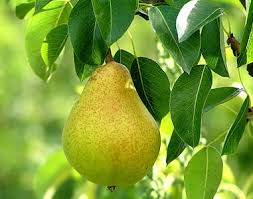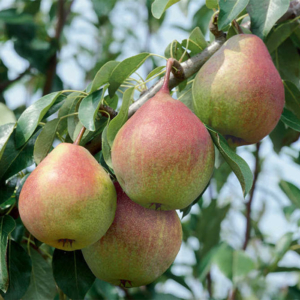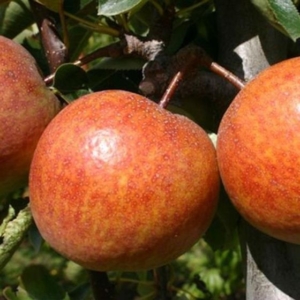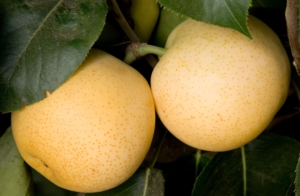Pears for 2025
*Most varieties of pear require cross-pollination with another pear.* While European pear can pollinize Asian pear, they typically are not in bloom at the same time. Thus, it is recommended to have two varieties of European pear or two varieties of Asian pear. A hybrid pear, such as Maxie, can act as pollinator for both since its bloom time is between the two.
European Pears
Bartlett: Perhaps the most widely grown European pear tree in history and cultivated in America since the early 1800’s. Classic bell shaped golden yellow fruit sometimes flushed red. Thin skinned, with creamy white flesh that is sweet and buttery. A multi-purpose pear grown for fresh eating, cooking, dessert, baking or juice. Ripens in September. Prone to scab. WSU Mt Vernon recommended variety. Early flowering; pollinize with Ubileen.
Comice: A highly acclaimed variety for its sweet, aromatic, fine texture, superb flavor and quality. It has a distinct shape: rounded with a short neck. Skin is greenish yellow with red blush. Late harvest. Self-fruitful but better with a pollinizer such as Bartlett.
Early Gold: This hardy pear is hard to beat if you’re looking for tasty fruit. Sweet and crisp, it is great for eating and holds up well in desserts, baked goods, and when canned. It ripens in early August. And if green/gold fruit isn’t tempting enough, it’s also a great ornamental tree with white flowers in spring and leaves that turn gold to purple in autumn. Self‑fruitful but may be more productive when paired with another European pear for pollinization.

Orcas: The original tree was found on Orcas Island. Large, beautiful, perfectly pear-shaped yellow fruit, with a red blush. Sweet and juicy, with smooth, buttery flesh. Good for fresh eating, or for canning and drying. Reliable and productive. Disease resistant. Ripens in September. Pair with Comice, Maxie or Seckel for a pollinizer. WSU Mt Vernon recommended variety.
Seckel: One for the collectors & connoisseurs! Sweet, flavorful, aromatic, spicy, perhaps the best flavor of any pear. Small and cute with russet brown skin. Resists fire blight. Self‑fruitful but may be more productive when paired with another European pear for pollinization.

Hybrid Pears
Maxie: Is a cross between Max Red Bartlett European and Nijisseki Asian pears, giving us the best of both worlds. This red & yellow fruit is great for fresh eating. It is crisp & juicy, sweet, and wonderfully aromatic. Maxie blooms in early April and ripens in mid-September. Resistant to pear scab. Pollinize with Hosui Asian Pear.

Asian Pears
Hosui: Introduced in the 1970s from Japan, this Asian pear is tangy with more acidity than most pears. The large fruit is sweet like a European pear but crisp like an apple, with gold skin and juicy flesh. Excellent for fresh eating or baking. Ripens in late August. Self-pollinating, but will yield more with a pollinizer such as ‘Shinseiki’.
Shinseiki: A beautiful, rounded pear with showy yellow skin. Sweet white flesh is crisp and very juicy. Very vigorous and productive. Good disease resistance. Stores very well. Ripens in early to mid-August. Needs a different Asian pear variety, such as ‘Chojuro’, as a pollinizer. WSU Mt Vernon recommended variety.

Espalier European Pears & 4 way Grafted
4 Way Asian Pear: Chojuro, Nijiseiki, Shinseiki, Shinko, +/or Kosui
Espalier European Pear: Bartlett, Red Bartlett, Bosc
Pear Rootstock:
OHXF 97: Vigorous, widely adapted and disease resistant. Unpruned tree height of fruiting varieties 15-25 ft. Trees on OHxF 97 may be held to any desired height by summer pruning.
OHXF 333: European and Asian pears on OHxF 333 are dwarfed to about 2/3 the size of standard, or about 12-18 ft. if not pruned. Widely adapted, disease resistant. Trees on OHxF 333 may be held to any desired height by summer pruning.
Pear Pollination Guide
In general, all pears need to be cross-pollinated by another pear that flowers at the same time. The safest is to choose another variety in bloom at the same time, but typically there is adequate overlap between each neighboring bloom category. For example, because ‘Maxie’ is a mid-season bloomer, it is used to pollinize both the early-blooming Asian pears and the later blooming European Pears.
Any variety in italics is one we have sold in the past but are not stocking this year.
| Early | Early to mid | Mid | Late |
| Hosui | Chojuro | Bartlett | Bosc |
| Shinseiki | Kosui | Early Gold | Comice |
| Nijiseiki | Maxie | Orcas | |
| Red Bartlett | Seckel | ||
| Rescue | |||
| Ubileen |
